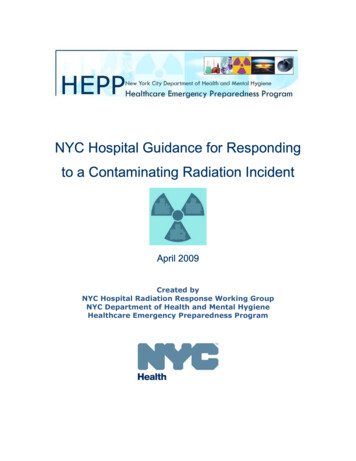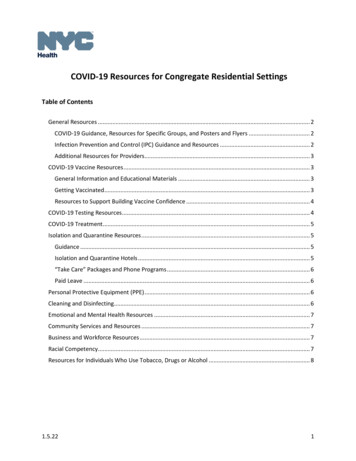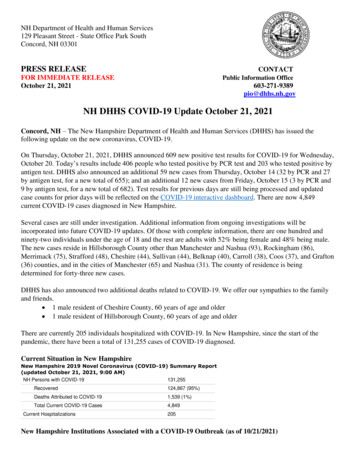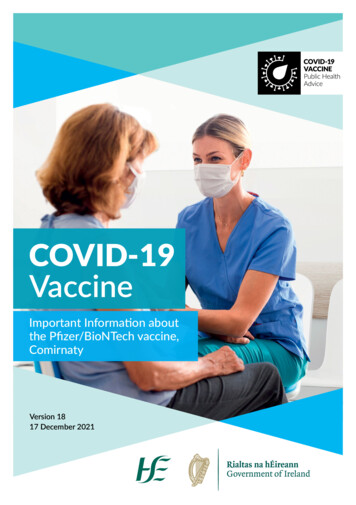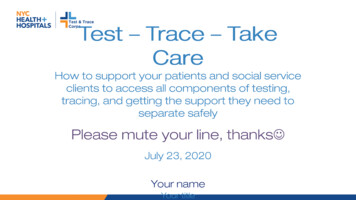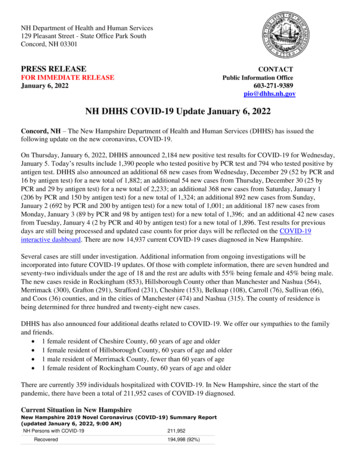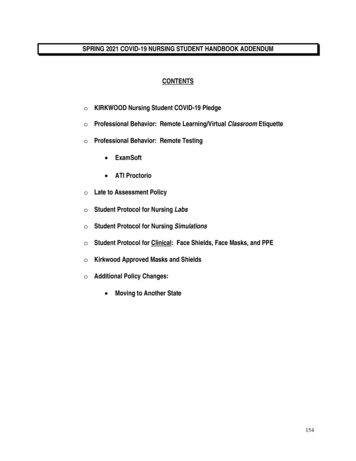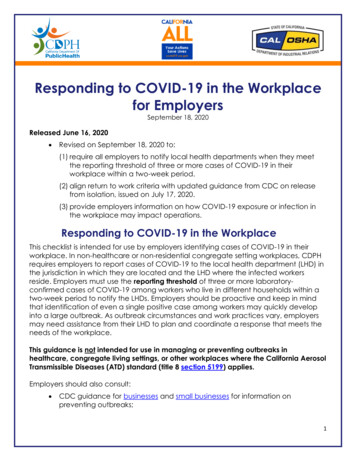
Transcription
Responding to COVID-19 in the Workplacefor EmployersSeptember 18, 2020Released June 16, 2020 Revised on September 18, 2020 to:(1) require all employers to notify local health departments when they meetthe reporting threshold of three or more cases of COVID-19 in theirworkplace within a two-week period.(2) align return to work criteria with updated guidance from CDC on releasefrom isolation, issued on July 17, 2020.(3) provide employers information on how COVID-19 exposure or infection inthe workplace may impact operations.Responding to COVID-19 in the WorkplaceThis checklist is intended for use by employers identifying cases of COVID-19 in theirworkplace. In non-healthcare or non-residential congregate setting workplaces, CDPHrequires employers to report cases of COVID-19 to the local health department (LHD) inthe jurisdiction in which they are located and the LHD where the infected workersreside. Employers must use the reporting threshold of three or more laboratoryconfirmed cases of COVID-19 among workers who live in different households within atwo-week period to notify the LHDs. Employers should be proactive and keep in mindthat identification of even a single positive case among workers may quickly developinto a large outbreak. As outbreak circumstances and work practices vary, employersmay need assistance from their LHD to plan and coordinate a response that meets theneeds of the workplace.This guidance is not intended for use in managing or preventing outbreaks inhealthcare, congregate living settings, or other workplaces where the California AerosolTransmissible Diseases (ATD) standard (title 8 section 5199) applies.Employers should also consult: CDC guidance for businesses and small businesses for information onpreventing outbreaks;1
Cal/OSHA guidance to ensure that they are complying with legal requirementsfor worker protection; and the California statewide industry-specific guidance to reduce risk during andafter reopening of businesses. See Resources section at end of document for links.2
Outbreak Management1. Employers should prepare for identification of COVID-19 casesin their workplace. Designate a workplace infection prevention coordinator to implement COVID-19infection prevention procedures and to manage COVID-related issues amongworkers. Instruct workers to stay home and report to the employer if they are havingsymptoms of COVID-19, were diagnosed with COVID-19, or are awaiting testresults for COVID-19.a. Symptoms of COVID-19 include subjective or measured fever ( 100.4 F or38 C), chills, cough, shortness of breath, fatigue, muscle or body aches,headache, new loss of taste or smell, sore throat, congestion or runny nose,nausea, vomiting, or diarrhea.b. Develop mechanisms for tracking suspected and confirmed cases amongworkers.c. Ensure that sick leave policies are sufficiently generous and flexible to enableworkers who are sick to stay home without penalty and ensure that workersare aware of such policies. California has additional services for workers, including supplemental paidsick leave for food sector workers at companies with 500 or more workersnationwide. Covered employers must provide notice to their workers of thisbenefit. The Families First Coronavirus Response Act requires certain employers toprovide workers with paid sick leave or expanded family and medicalleave for specified reasons related to COVID-19. Some cities and counties require employers to provide sick leave benefitsto workers.Identify contact information for the local health department (LHD) in thejurisdiction where the workplace is located.2. Employers must prepare to share information with the LHD andother stakeholders. Employers must notify the LHD in the jurisdiction where the workplace is located ifthere is a known or suspected outbreak in the workplace. An outbreak in nonhealthcare or non-residential congregate setting workplaces is defined as threeor more laboratory-confirmed cases of COVID-19 among workers who live indifferent households within a two-week period. Employers are also encouragedto contact the LHD regarding any laboratory confirmed case of COVID-19 in theworkplace.3
a. The LHD in the jurisdiction where the workplace is located may have specificadditional criteria for outbreak reporting requirements. Employers must followthe specific instructions of their LHD, if available.b. LHDs regularly transmit and protect confidential health information. Securelysharing confidential information about workers with COVID-19 is critical for theLHD to provide comprehensive support to the employer and protect thehealth of the community. Workers in a workplace may live in counties/jurisdictions outside of where theworkplace is located. When the case reporting threshold is met, employers mustcontact the LHD in any jurisdiction where a COVID-19 positive worker resides andlet them know about the outbreak.a. Typically, the LHD in the jurisdiction where the workplace is located givesguidance to the employer on managing the outbreak. Communicate with the LHD on how frequently the LHD expects updates from theemployer on newly identified cases and symptomatic workers in the workplace.a. Determine how this information will be shared (e.g., telephone, fax directed toa specified person, secure e-mail). Share a roster of all workers with the LHD in the jurisdiction where the workplace islocated.a. An employer may be asked by the LHD to provide additional information onthe workers, including job description, location, work schedule, city andcounty of residence, and other details that could help inform the investigationand determine which other workers in the workplace may be at risk of COVID19 infection. If workers in a facility are unionized, identify a union contact and clarify the rolethe union can play in communication with workers. If workers in a facility are notunionized, identify a worker representative to serve as a point of contact for theLHD. If the facility uses contract or temporary workers, identify who shouldcommunicate information and instructions on the outbreak to these individuals.a. The host employer should notify temporary, contract, or other agencies thathave workers in the workplace of the outbreak.b. All workers in the workplace, regardless of employment arrangement, shouldfollow all instructions for infection prevention and outbreak managementmeasures from the host employer, the LHD where the workplace is located,and the LHD were they reside.3. Understand requirements for reporting worker cases toCal/OSHA. Any serious injury, illness, or death occurring in any place of employment or inconnection with any employment must be reported by the employer to the localCal/OSHA district office immediately but not longer than 8 hours after theemployer knows. For COVID-19, this includes inpatient hospitalizations and deathsamong workers.4
Employers must report serious injury, illness, and death, including hospitalizationand death from COVID-19, even if work-relatedness is uncertain. Cal/OSHA prefers calls by phone but will also accept email reports(caloshaaccidentreport@tel-us.com). Details on Reporting-Requirements-COVID19.html), contact information for district es.htm), and the Title 8 section 342requirement (https://www.dir.ca.gov/title8/342.html) are available online.4. Identify additional worker cases and close contacts of cases tocontrol further spread in the workplace. Testing all workers in a workplace should be the first strategy considered foridentification of additional cases. Testing may be done at a single point in time orat repeated intervals.a. Employers should seek guidance from the LHD when developing a testingstrategy, including how testing can be arranged and how to prioritize testingof workers. Examples of strategies may include testing close contacts oflaboratory-confirmed cases first; prioritizing workers in parts of the workplacewith higher case counts; or, if testing capacity is limited, sample pooledtesting, also known as “group testing,” should be conducted to obtain criticalinformation about the extent of infection with fewer testing resources.b. Employers should offer on-site COVID-19 testing of workers or otherwisearrange for testing through the company’s occupational or general medicalservices provider. The employer is responsible for ensuring all workers areoffered and provided testing. Employers should also provide information toworkers who may prefer to contact their personal medical provider or visit aCA Coronavirus Testing Task Force site (https://testing.covid19.ca.gov/) fortesting. LHDs may also be able to help facilitate testing options, if needed. When testing all workers is not available or not recommended by the LHD,consider alternative methods for controlling the outbreak, in consultation with theLHD, including but not limited to tracing all close contacts of confirmed casesand instructing those individuals to quarantine, conducting sample pooling(group testing), or temporarily closing the workplace and quarantining allworkers. Conduct contact tracing and quarantining of close contacts of confirmed casesin the workplace.a. Employers must provide information to the LHD on the confirmed COVID-19case workers in the workplace, including job titles, work areas, close contactsin the workplace, dates of symptom onset, and shifts worked while infectious.b. Establish if the employer, LHD, or both will conduct interviews of the cases todetermine their close contacts.c. Close contacts should be instructed to quarantine at home for 14 days fromtheir last known contact with the worker with COVID-19. Close contactsshould be tested for COVID-19 when possible.5
d. A close contact is someone who spent 15 minutes or more within 6 feet of anindividual with COVID-19 infection during their infectious period, whichincludes, at a minimum, the 48 hours before the individual developedsymptoms.e. Interview workers with laboratory-confirmed COVID-19 by phone to determinewhen their symptoms began, the shifts they worked during their infectiousperiod, and to identify other workers with whom they had close contactduring their infectious period.f.Use employment records to verify shifts worked during the infectious periodand other workers who may have worked closely with them during that timeperiod.g. While at home, close contacts should self-monitor daily for COVID-19symptoms (e.g., subjective or measured fever ( 100.4 F or 38 C), chills, cough,shortness of breath, fatigue, muscle or body aches, headache, new loss oftaste or smell, sore throat, congestion or runny nose, nausea, vomiting, ordiarrhea).5. Consider whether to temporarily suspend operations due toCOVID-19 infection in the workplace Businesses may elect to voluntarily suspend operations when a case ofCOVID-19, exposure to COVID-19, or an outbreak has occurred in theworkplace. This would allow investigation of the exposure and thoroughcleaning and disinfection. Businesses may elect to do this if the exposure isin a worker, customer, or visitor of the workplace. To understand moreabout if this decision is right for your business, you can contact your localhealth department (LHD) for guidance. The LHD in the jurisdiction where the workplace is located has the authorityto close business operations while an exposure is being investigated or anoutbreak is being managed. Cal/OSHA also has authority to prohibit useand access of affected areas of a workplace if it identifies an imminenthazard to workers. Criteria for making a determination for closure may include the size of theworkforce, the number or percentage of the workforce impacted, thevulnerability of consumers who visit the business to severe COVID-19infection, or many other local factors, including the epidemiology ofdisease spread in the community at large. LHDs may vary in their specific requirements for workplace outbreakinvestigations, reporting, and suspension of operations.6. Notify and provide instruction to workers. Employers must maintain confidentiality of workers with suspected or confirmedCOVID-19 infection when communicating with other workers.6
Employers should notify all workers who were potentially exposed to theindividuals with COVID-19. Employers should provide any healthcareconsultations needed to advise workers regarding their exposure, which may beespecially important for those with high-risk medical conditions (e.g., immunecompromise or pregnancy). Close contacts of cases should be given instructions on home quarantine,symptom monitoring, and COVID-19 testing. Provide any workers who are sent home before or during a shift with informationabout what to expect after they are sent home (e.g., instructions about testing,sick leave rights under federal, state, and local laws and company policies,return-to-work requirements, etc.). In some outbreaks, but not all, workers who were never symptomatic and did nothave close contact with any of the laboratory confirmed cases may continue towork, as long as the employer has implemented all control measures asrecommended by public health authorities, Cal/OSHA, or other regulatorybodies. The LHD will make this determination based on strategies being used tocontrol the outbreak and identify new cases.7. Determine when it is appropriate for cases and contacts ofcases to return to work. Consult with the LHD and most recent CDC guidance for when a confirmed casemay be released from home isolation and return to work. The local healthdepartment may recommend a strategy for return to work similar to the following,although some variation may occur by jurisdiction and outbreak.Minimum Criteria for Return toWork(As of September 18, 2020)Symptomatic PositiveWorkers with symptoms whoare laboratory confirmed tohave COVID-19At least 10 days havepassed since symptoms firstappeared; and at least 24hours have passed since lastfever without the use of feverreducing medications; andsymptoms (e.g., cough,shortness of breath) haveimproved.CDC Reference Page(The most recent CDCguidance should beconsulted prior to allowing theworker to return to work)For worker cases who did notrequire 19ncov/hcp/disposition-inhome-patients.htmlFor worker cases who .html7
Minimum Criteria for Return toWork(As of September 18, 2020)Asymptomatic PositiveWorkers who never hadsymptoms and are laboratoryconfirmed to have COVID-19Symptomatic NegativeWorkers who had symptomsof COVID-19 but test resultreturned negativeAsymptomatic NegativeWorkers who never hadsymptoms but were testeddue to close contact with alaboratory-confirmed casepatient and were negativeSymptomatic UntestedWorkers who had symptomsof COVID-19 but were nottestedA minimum of 10 days havepassed since the date of theirfirst positive COVID-19 test. Ifthey develop symptoms, thenthe criteria for laboratoryconfirmed cases withsymptoms apply.CDC Reference Page(The most recent CDCguidance should beconsulted prior to allowing theworker to return to disposition-inhome-patients.htmlUse the same criteria forreturn to work as laboratoryconfirmed cases.Workers should quarantine athome for 14 days after the lastknown close contact with thecase patient. Symptoms candevelop even after testingnegative within 14 days afterexposure. The LHD mayconsider allowing earlierreturn to work only for aworker in a criticalinfrastructure industry in whichthe essential operations of theworkplace would becompromised by quarantineof the worker and noalternate staff can performthe same role.*Testing is highlyrecommended. If the workercannot be tested, use thesame criteria for return to workas laboratory confirmedcases.8
Minimum Criteria for Return toWork(As of September 18, 2020)Asymptomatic UntestedWorkers who had closecontact to a laboratoryconfirmed case patient atwork, home, or in thecommunity and do not havesymptoms.ORWorkers who refuse or areunable to be tested afterclose contact with alaboratory-confirmed case,despite recommendation fortesting from LHD orhealthcare provider, and donot have symptoms.Workers should bequarantined at home for 14days after the last knownclose contact with the casepatient. Testing is highlyrecommended; if testing hasnot occurred, the LHD mayconsider allowing a workerwho had close contact to aconfirmed case to continueto work only in a criticalinfrastructure industry in whichthe essential operations of theworkplace would becompromised by quarantineof the worker and noalternate staff can performthe same role.*CDC Reference Page(The most recent CDCguidance should beconsulted prior to allowing theworker to return to mplementing-safetypractices.htmlWorkers who developsymptoms of COVID-19 whilein quarantine should contacttheir healthcare provider.Even if they are not tested,the same criteria for return towork should be used aslaboratory-confirmed cases.* Critical infrastructure workplace outbreak asymptomatic negative workers workers who were close contacts to confirmed casesWhere 14-day quarantine would compromise essential operations, the LHD maydetermine that some workers in these two groups may return to work sooner than 14days by considering certain criteria specific to the workplace and worker: The worker is able to wear a surgical mask throughout the workday, except whileeating, and comply with all infection prevention procedures. A cloth facecovering may also be used in the event of mask shortage. The facility has implemented all best practice infection prevention procedures, asdetermined by the LHD.9
Pre-screening to assess worker temperature and symptoms prior to starting workhas been implemented, ideally before entering the facility. Worker is able to self-monitor for temperature and symptoms at home and work. Worker is able to maintain a minimum of six feet of distance from other workers inthe workplace. Of note, six feet does not prevent all transmission of SARS-CoV-2. Physical barriers are in place between fixed work locations to supplementdistancing. Cleaning and disinfection of all areas and shared equipment can be performedroutinely in the workplace.Be aware that testing reflects a worker’s status at a single point in time only. If a workertests negative, they may still develop COVID-19 infection from a recent or subsequentexposure and should be instructed to quarantine at home if that occurs. Testing may beneeded at repeated intervals to capture all positive cases, especially if an outbreak isongoing.8. Perform more frequent cleaning and disinfection, as well asdeep/enhanced cleaning and disinfection after workers withCOVID-19 have been at work. Work areas of infected workers should not be entered by workers until they havebeen cleaned and disinfected with products approved by the EPA for COVID-19.Work should be performed by cleaning staff trained on their safe use andsupplied with all required and recommended PPE. Perform ongoing enhanced cleaning/disinfection of work areas when a workerwith COVID-19 is identified, following CDC on.html Continue to identify and regularly clean and disinfect frequently touchedsurfaces throughout the workplace, such as doorknobs, equipment, andhandrails. Workers should not share headsets or other objects that may come into contactwith their face, mouth, or nose. Minimize sharing of other equipment between workers; for equipment that mustbe shared, conduct frequent cleaning between worker use. Train workers on safe use of cleaners and disinfectants and provide necessaryprotective equipment.9. Employers should regularly check for and follow new andupdated guidance on their specific industry from the followingsources: Governor’s Office Resilience Roadmapa. Guidance for multiple industries: https://covid19.ca.gov/industry-guidance/10
Cal/OSHAa. General Industry eneral-Industry.htmlb. Guidance for specific /Health-Care-General-Industry.html CDCa. Landing page for workplaces: /organizations/businesses-employers.htmlb. Landing page for industry specific worker safety onal ResourcesCDC guidance: For employers: /guidance-business-response.html For office buildings: /office-buildings.html For childcare, schools, and youth /community/schoolschildcare/index.html Worker safety and support for a variety of industries: Worker Safety and Support For small businesses: /guidance-small-business.html For meat and poultry processing orkers-employers.html Grocery and Food Retail: /organizations/grocery-food-retail-workers.html Transportation and Delivery: /transportation/index.html Conserving and Extending Filtering Facepiece Respirator Supply in NonHealthcare Sectors: /conserving-respirator-supply.html Communities, Schools, Workplaces, and Events - Guidance for Where You Live,Work, Learn, Pray, and Play: /index.html First Responders and Law Enforcement: /first-responders.html11
Cal/OSHA guidance: e-General-Industry.html For general industry: ustry.html For agricultural employers: fection-Prevention-in-Agriculture.pdf For childcare programs: pdf For construction: nfectionPrevention-in-Construction.pdf For grocery stores: nfectionPrevention-in-Grocery-Stores.pdf For logistics employers: fection-Prevention-in-Logistics.pdf For mortuaries and funeral D-19-Infection-Prevention-inMortuaries.pdf Interim Guidance on COVID-19 for Health Care Facilities: Severe Respirator SupplyShortage: uidance-forrespirator-shortages.pdfGovernor’s Office Resilience Roadmap guidance and employer checklists: Multiple industries: https://covid19.ca.gov/industry-guidance/12
1 Responding to COVID-19 in the Workplace for Employers September 18, 2020 Released June 16, 2020 Revised on September 18, 2020 to: (1) require all employers to notify local health departments when they meet


